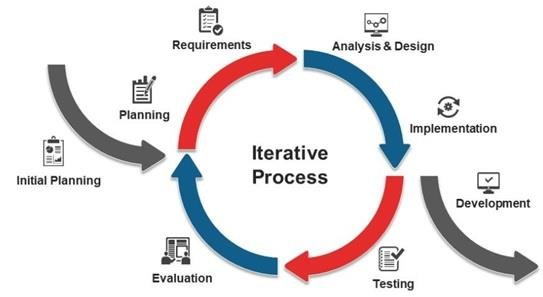Project Execution Models
Project Execution at V4U Technologies
We utilize a range of project execution models to guarantee timely delivery and high-quality software solutions. Depending on the project's requirements, scope, and functionalities, we employ DevOps, Agile, Waterfall, or Iterative approaches. Our thorough execution strategy and careful selection of the appropriate model enable us to achieve superior, faster, and more effective results.

Our project execution methodologies adhere to the guidelines established by the Project Management Body of Knowledge (PMBOK) and led by the Project Management Institute (PMI). These methodologies ensure high quality while managing cost, scope, and time requirements for each project.
They are proven, dependable, and comprehensive.
Software Development Process that works for your Business
Agile Software Development Model
The Agile Software Development Methodology promotes collaboration between project teams to accommodate evolving requirements. At V4U Technologies, we employ Scrum and Kanban practices to manage software and application development. Our development team works closely with customer project stakeholders at every stage to deliver market-ready software. To support the successful execution of Agile processes, we utilize tools such as JIRA and Bitbucket.
Our adoption of Agile methodology makes your software development projects more efficient, flexible, and responsive to your unique needs. Think of Agile as assembling a puzzle piece by piece, with regular check-ins to ensure quality and functional components delivered at consistent intervals. This approach allows us to gather feedback early, make prompt adjustments, and adapt to changing requirements. Agile enhances our commitment to collaboration, adaptability, and delivering consistent value.
- Iterative Progress and Flexibility: Agile breaks projects into manageable phases, allowing for continuous adaptation to evolving requirements and market conditions.
- Client Collaboration for Prioritization: Frequent client involvement fosters collaboration and helps prioritize the most valuable features, ensuring alignment with expectations.
- Cross-functional Teams for Quality Assurance: Diverse teams with various skills enhance collaboration, while ongoing testing and quality checks ensure a high-standard product.
- Transparency and Rapid Delivery: Agile promotes open communication for project status visibility and aims to deliver working increments quickly, reducing time-to-market.
- Adaptation and Process Optimization: Agile teams regularly review and adjust their processes, continually optimizing for efficiency and effectiveness.
- Customer Satisfaction as Central Focus: Agile emphasizes customer satisfaction, delivering value, and consistently meeting client needs.

Software Development with Agile Frameworks
The Agile software development process integrates continuous planning, testing, integration, and other forms of ongoing development. Agile frameworks emphasize continuous improvement and rapid iterative cycles to deliver value to customers efficiently.
Scrum Framework: Strive for Super-Perfection
Scrum excels through iterative sprints, breaking projects into manageable cycles to maximize business value in the shortest time. With sprints lasting two to four weeks, Scrum facilitates the delivery of working software at the end of each cycle. This approach ensures faster feedback, greater adaptability, and continuous improvement throughout the development process.
Kanban Framework: Master Chaos with Kanban
In the absence of precise task management, chaos can quickly take over, leading to missed deadlines, increased stress, and diminished accountability. Kanban provides a solution by offering clarity and streamlining workflows. It visualizes work, limits tasks in progress, and fosters continuous improvement. Embrace Kanban boards to achieve efficient and effective task management.
Scrumban Framework: The Best of Both Scrum and Kanban
Scrumban merges the strengths of both Scrum and Kanban, offering an ideal middle ground between the two. Its main goal is to integrate continuous improvement within the Kanban framework while preserving the familiar structure of Scrum. This approach facilitates a flexible transition between Kanban and Scrum based on project needs, adapting to requirements and enhancing overall efficiency.
The Waterfall Model
The Waterfall methodology adopts a linear approach, where each stage of the project depends on the completion of the previous one.
This model involves a sequential progression through requirements analysis, design, implementation, testing, deployment, and maintenance.
As this model emphasizes planning in early stages, it keeps a check on design flaws before development. In addition, its intensive document and planning make it work well for projects in which quality control is established well as in all our projects.
This method is easy to understand and implement and reinforces one of the best practices for software development.
- Ideal for large teams that have a clear understanding of the project's scope.
- Necessitates a well-defined scope, objectives, and expectations before development begins.
- Most effective for small projects with clearly defined requirements that are unlikely to change significantly during development.

The Iterative Model

The Iterative Development approach breaks the project into smaller segments, enabling the development team to showcase results early and gather valuable feedback from users. Each iteration follows a Waterfall-like process, where feedback from one phase informs the next. In some variations of this model, software deliverables are released incrementally into production at the end of each step.
The iterative process involves a continuous cycle of planning, analysis, implementation, and evaluation. Each cycle produces a segment of development that forms the basis for the next cycle of iterative improvement. You'll start with initial planning and defining overall requirements.
Each phase produces specific deliverables and requires a clear understanding of requirements, making this approach highly reliable.
- Iterative development enables you to continually show key stakeholders how the project is going.
- Testing provides regular evidence that you are moving in the right direction and creating value for your users.
- When stakeholders see this they become more confident in what you are doing.
Looking for a Software Development Partner?
Dedicated developers at V4U Technologies offers stable services that serve the needs of your businesses regardless of size, industry verticals, and locations. Our approach towards software development is based on simple work-flows and innovative applications with high quality. Share your priorities with us and experience personalized assistance firsthand.
Contact Our Team